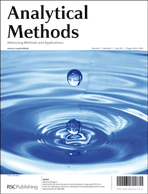A rapid method for the in-field analysis of amphetamines employing the Agilent Bioanalyzer
Abstract
This paper reports the first analysis of small molecules on the Agilent bio-analyser. The Bioanalyzer is a commercial lab-on-a-chip instrument designed for the analysis of DNA and


 Please wait while we load your content...
Please wait while we load your content...